CLEAN APPLES, EDIBLE APPLES
Popular Though They May Be . . .
Apples may be a common fruit, second worldwide and in the U.S., bested only by bananas, but they surely are not the easiest ones to grow. At least not over much of this country east of the Rocky Mountains, and here on my farmden. Throughout this area, insects and diseases are ready to pounce on virtually every unsuspecting apple tree.
Pesticides will control these pests but, if needed, are effective only if used rigorously: trees must be regularly and thoroughly doused with the correct material, used at the correct concentration, and applied at the correct times. No wonder the average gardener is daunted at the thought of growing apples!
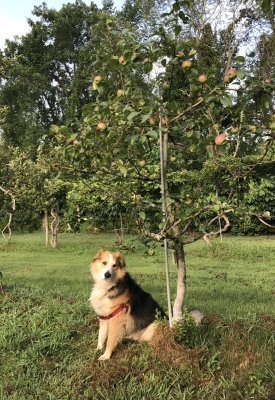
Dwarf Liberty apple tree & Sammy
The prospects for backyard apples, organic apples, even in pest-prone regions brightened a few decades ago. Not all apple varieties are equally susceptible to diseases, and apple breeders went to work.
Unfriendly Fungi
Most breeding effort has been directed against apple scab, the most threatening disease of apples, which causes leaves to fall prematurely and defaces fruits with ugly, brown scabs. 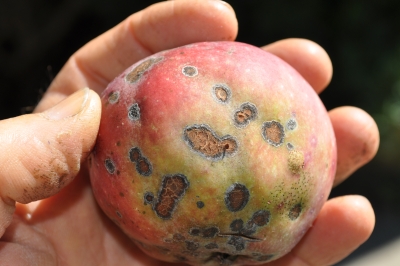 Early introductions were varieties from joint breeding programs of Purdue, Rutgers, and Illinois Universities. To symbolize the cooperative effort, these apples had the letters P, R, and I incorporated into their names: Prima, Priam, and Sir Prize.
Early introductions were varieties from joint breeding programs of Purdue, Rutgers, and Illinois Universities. To symbolize the cooperative effort, these apples had the letters P, R, and I incorporated into their names: Prima, Priam, and Sir Prize.
These varieties are not the only ones resistant to scab. Some newer varieties, such as Mutsu (Crispin), Jonagold, and Spigold, were bred for fruit quality rather than scab-resistance per se, but happen to be fairly resistant to scab. Even some older varieties, such as Bramleys Seedling, Golden Delicious, Grimes Golden, Jonathan, Wolf River, and York, resist scab. Macintosh and related varieties, such as Cortland, Empire, Macoun, and Jerseymac, are very susceptible.
Scab isn’t the only microorganism waiting to pounce on your apple trees. Apples over much of eastern U.S. are also attacked by other diseases, such as cedar-apple rust, mildew, and fire blight, this last one a bacterial disease. As with scab, certain varieties are able to fend off one or more of these other diseases. But just because a variety resists one disease does not imply that it resists another one. For example, McIntosh and its relatives are resistant to cedar-apple rust. On the other hand, Golden Delicious and some of its relatives, such Jonagold and Pink Lady, are scab-resistant, but very susceptible to cedar-apple rust.
So why not develop an apple resistant to all the major diseases? Some success has been achieved in this direction by breeders. Varieties such as Redfree, Novamac, Macfree, and William’s Pride are at least somewhat resistant to all four major diseases, as is the “PRI” variety Priscilla. A few old varieties, such as Duchess of Oldenburg, Quinte, Mollie’s Delicious, and Bramleys Seedling, also are in this category. Liberty is also in this group, and, with Macoun as one of its parents, it’s no wonder it’s one of my favorites for good taste also.
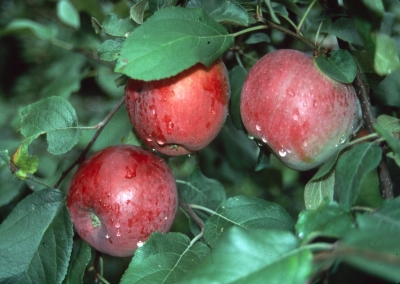
Liberty apple
Pesky Pests
Unfortunately, even disease-resistant apples often need some spraying — for insects. Insects are as fond of disease-resistant apples as they are of disease-susceptible apples. But by growing a disease-resistant variety and using certain sprays and traps, apples can be grown organically even in pest-prone regions. Well, almost. The first prerequisite is a good site, ideally on a slope not too close to woodlands and where the sun beams down at least six hours per day. Picture the opposite of these site conditions and you can understand my difficulties in growing apples.
Just a few major insects attack apples. One is the plum curculio.
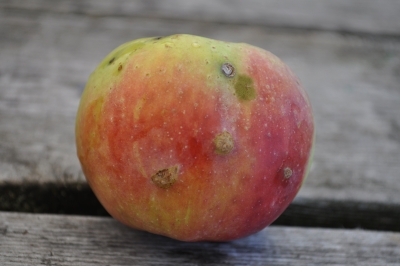
Curculio damage
But there is a spray for this and other insects. It’s nothing more than kaolin clay, sold as Surround. The downside to this spray is that three coats are needed just before growth begins in spring. Following that, spraying is needed every week until the end of June. Surround will also control other insect pests, so the sprays can be continued for much of the season. All this spraying paints the trees with a white coating to give them a very Mediterranean look; I tell visitors here that the trees are olive trees. That coating is what bothers the insects.
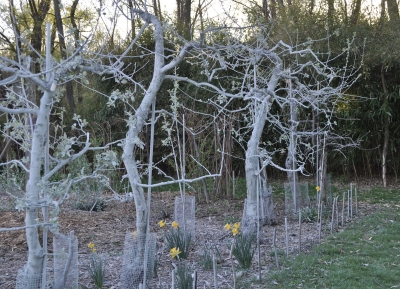
Trees sprayed with Surround
At the end of June, if you’re tired of all that spraying, change tactics instead, with trapping. Apple maggots, left unchecked, can tunnel throughout the fruit, dimpling the surface and rendering them totally inedible — unless you like eating maggots. This insect’s Achille’s heel is its attraction to the red color of apples. You can purchase spherical red traps and coat them with forever-sticky Tangletrap, hanging one per dwarf tree, more for larger trees. Ms. Maggot mistakes these spheres for apples and tries to lay eggs in them, the last eggs she ever tries to lay.
I use real Red Delicious apples as traps. They’re cheaper and, except for their awful taste, are apples visually and perhaps scent-wise. I coat them with Tangletrap and at the end of the season, I just toss them in the compost pile. Those real apple traps are sometimes good for the whole season; if not, I just buy more for traps.
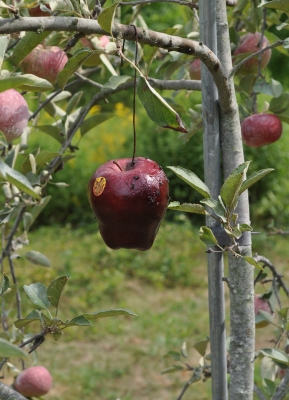
Red Delicious apple maggot trap
Over the past decades, people have come up with many concoctions and schedules for thwarting pests so that apples can be grown organically. I, along with many other long-time fruit growers, roll our eyes at these efforts. It’s mostly newbies that use them — and then for only a few years.
Traveling around coastal Maine one recent autumn, I noticed many wild apple trees and was surprised to find how free from blemishes they were. Evidently, certain combinations of site, varieties, and weather allow for more or less pest-free apples with no interventions at all. Maybe you have such conditions. I don’t.
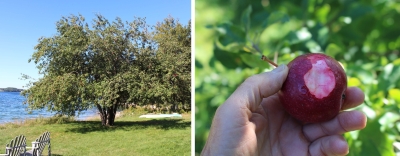
Wild apple and its fruit, Maine
Not that I don’t grow fruit organically. Besides blueberries, raspberries, gooseberries, and other berries, I enjoy pears, persimmons, and many other fruits, all organically grown without the need for any sprays.

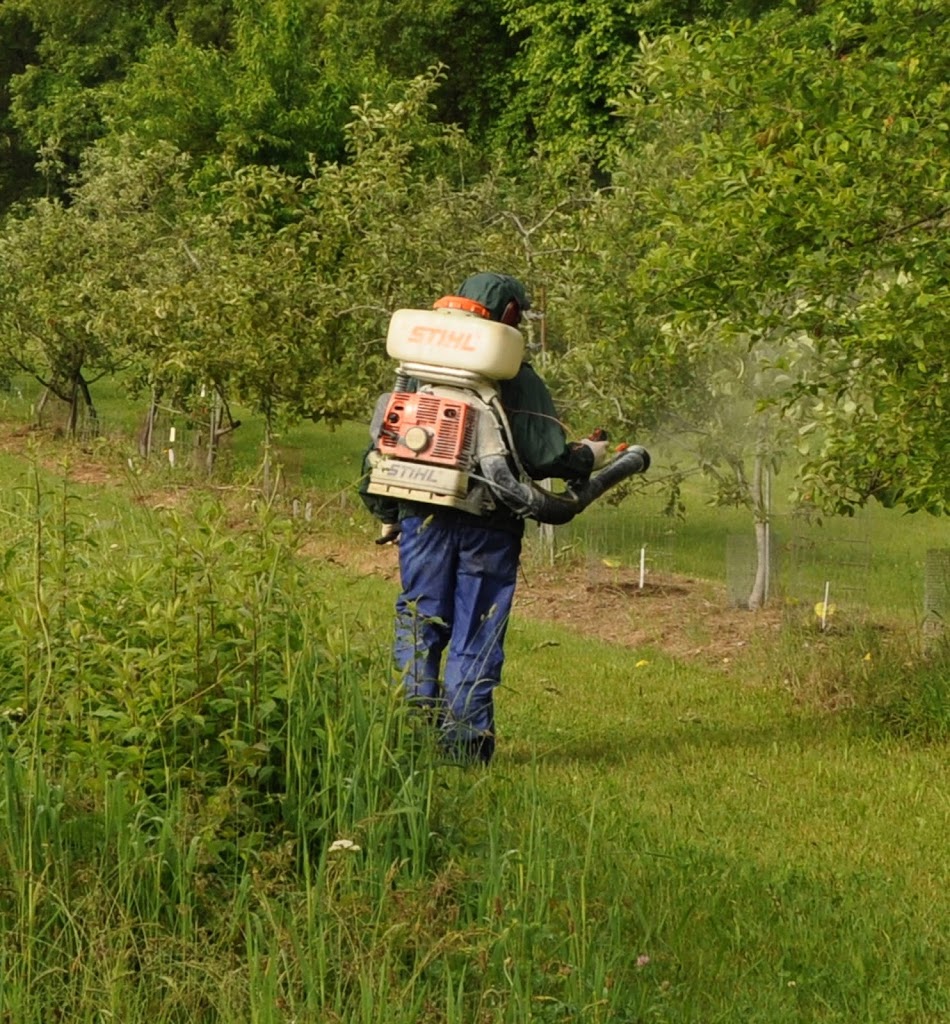
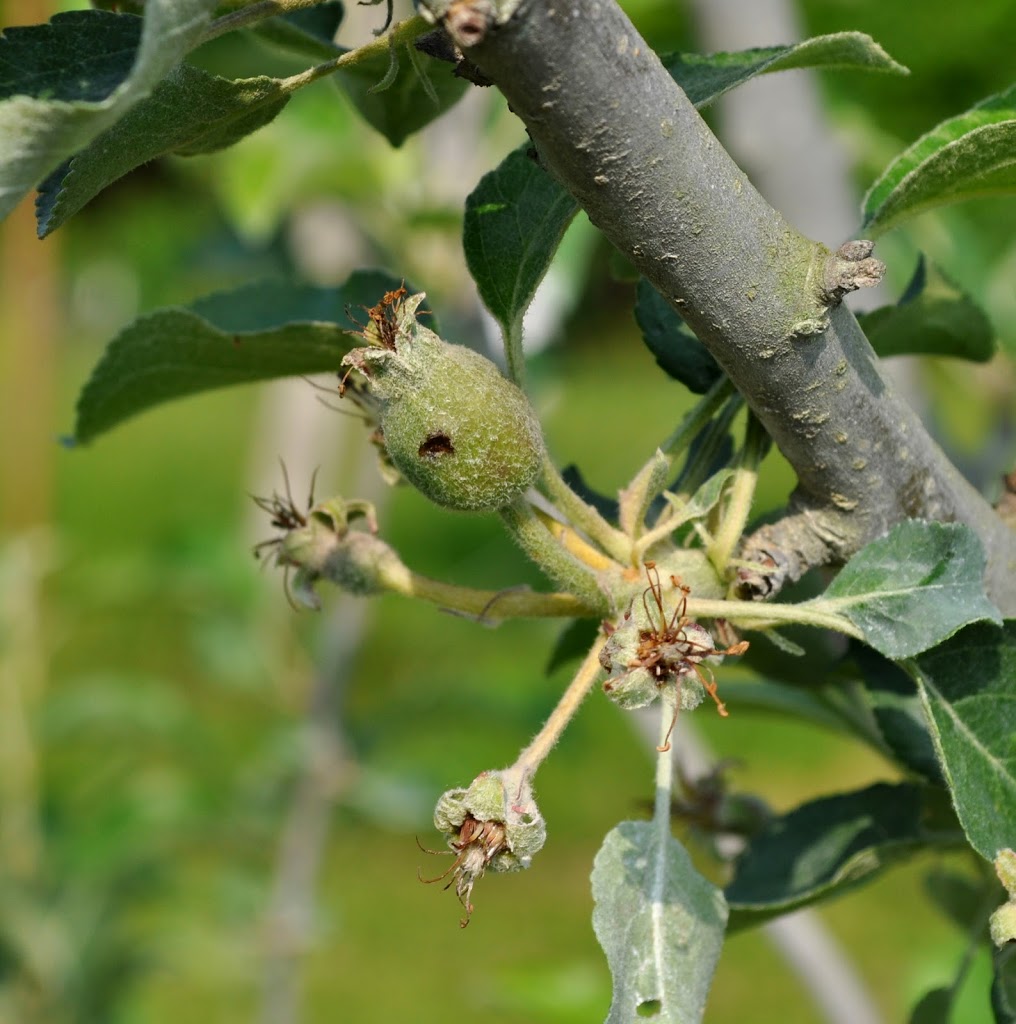
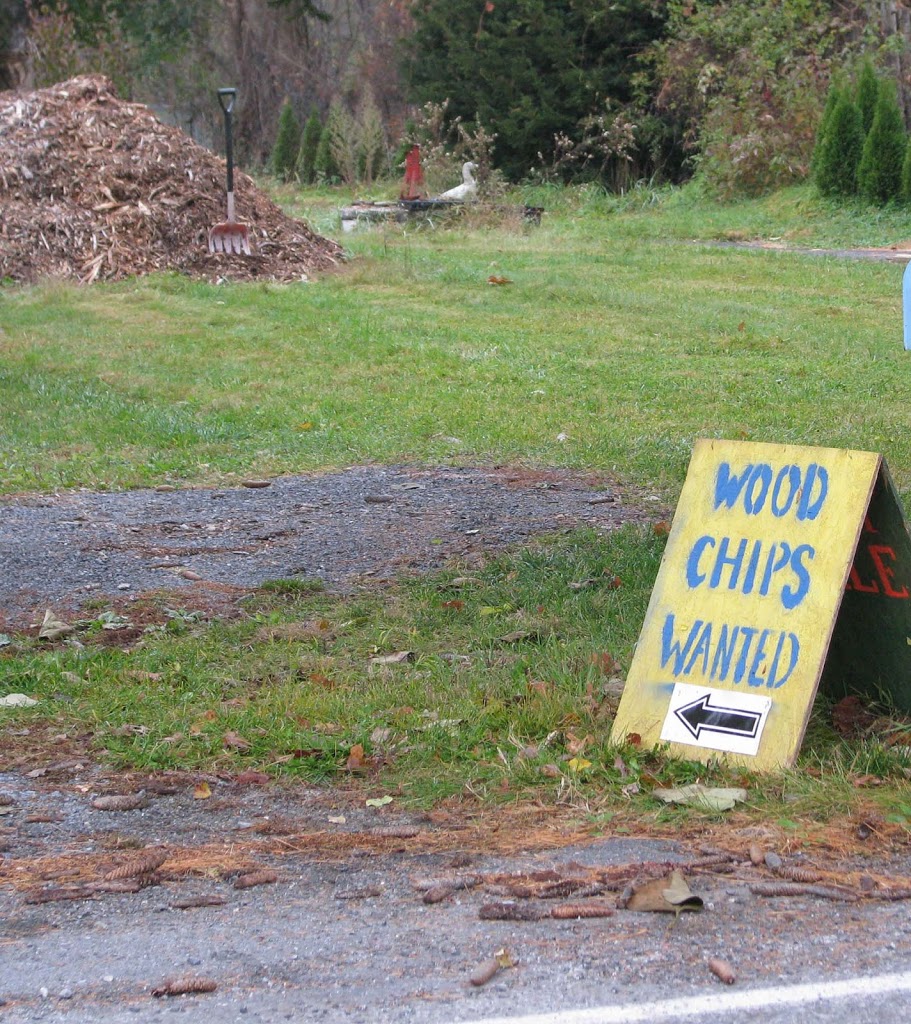



Thank you for the insightful post. What pests are you protecting against with Surround in early spring? I typically spray Surround after young apples emerge. I haven’t had pest issues yet on my apples, but peach tree borers have been the death of me.
The early spray is for plum curculio.
Hello,
I got an orchard in the czech republic and it’s under attack – the common voles eat the bark and roots. Any ideas beyond nasty chemicals as to how to get rid of the voles?
I put plastic spiral collars around the trunks in winter. Painting with diluted white latex paint to which some bone mea has been added helps. Also, cylinder of 1/4″ hardware cloth (metal mesh) pushing into the ground around trunks. And finally, cats.
Surround does the job but spray surround only if you like to spend hours and hours scrubbing it off your harvest.
I have placed an order for several apple trees, each approx. 4′ to 5′ ft tall, and I would like to find out how to best protect them from the many deer and rabbits in our area. I like vinyl covered green fencing, such as green chicken wire and 1/2-inch green hardware cloth, and I have some green plastic fencing left over. Can I use this type of fencing to protect the trees, or should I use a different type, and how wide or tall should the fence be? Thank you!
The fencing you described probably would work as long as deer can’t push it in to get at the plant. I prefer 2×4 welded wire fencing 5 or 6 feet high and formed into 3 or 4 foot diameter cylinders.
Hi Lee, it’s already almost the end of June. I have an apple tree that the 3 year old loves, but this year the fruit has a pest, fungi or maggots of some kind. My tree is very tall and it was here when we bought the house. Is there anything I can do at this point to combat the pest or is it too late? Thank you!
Probably too late bet any pest control starts with knowing what pest you have to control. ID the pest itself or by the damage it produces.
Hi Lee
I’m not too far from you in Beacon, NY. Have you tried using organza bags to protect fruit? It can be tedious but I used it with Surround on my Asian pears last year with good success. Hopefully I get some apple fruit this year to try it on
I have tried organza bags, mostly to keep European hornets at bag. Hornets and birds pecked right through the bags!
thanks for the great article, keep up the good work